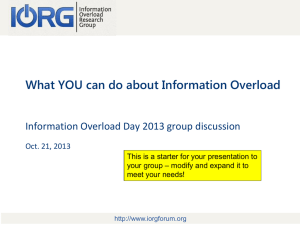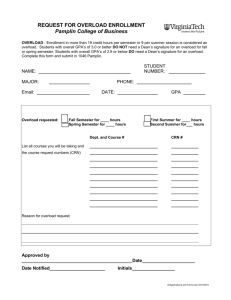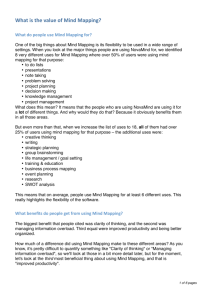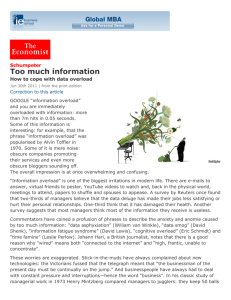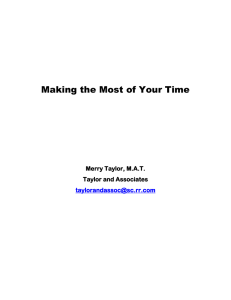Stephen Voida Research Statement, December 2012
advertisement
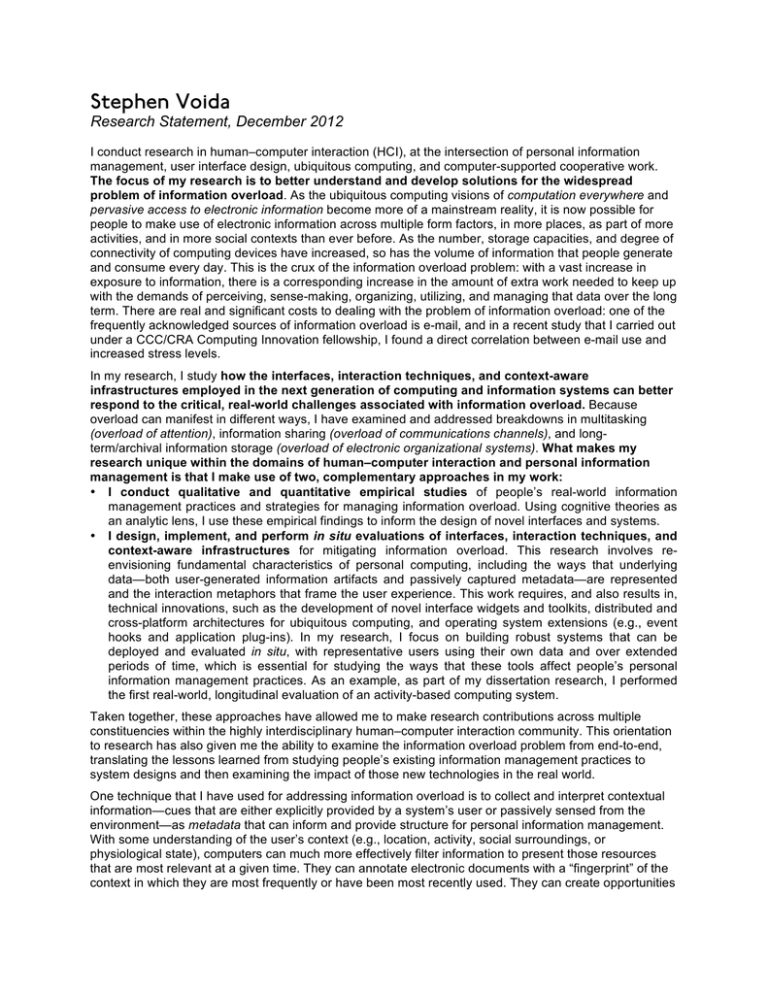
Stephen Voida Research Statement, December 2012 I conduct research in human–computer interaction (HCI), at the intersection of personal information management, user interface design, ubiquitous computing, and computer-supported cooperative work. The focus of my research is to better understand and develop solutions for the widespread problem of information overload. As the ubiquitous computing visions of computation everywhere and pervasive access to electronic information become more of a mainstream reality, it is now possible for people to make use of electronic information across multiple form factors, in more places, as part of more activities, and in more social contexts than ever before. As the number, storage capacities, and degree of connectivity of computing devices have increased, so has the volume of information that people generate and consume every day. This is the crux of the information overload problem: with a vast increase in exposure to information, there is a corresponding increase in the amount of extra work needed to keep up with the demands of perceiving, sense-making, organizing, utilizing, and managing that data over the long term. There are real and significant costs to dealing with the problem of information overload: one of the frequently acknowledged sources of information overload is e-mail, and in a recent study that I carried out under a CCC/CRA Computing Innovation fellowship, I found a direct correlation between e-mail use and increased stress levels. In my research, I study how the interfaces, interaction techniques, and context-aware infrastructures employed in the next generation of computing and information systems can better respond to the critical, real-world challenges associated with information overload. Because overload can manifest in different ways, I have examined and addressed breakdowns in multitasking (overload of attention), information sharing (overload of communications channels), and longterm/archival information storage (overload of electronic organizational systems). What makes my research unique within the domains of human–computer interaction and personal information management is that I make use of two, complementary approaches in my work: • I conduct qualitative and quantitative empirical studies of people’s real-world information management practices and strategies for managing information overload. Using cognitive theories as an analytic lens, I use these empirical findings to inform the design of novel interfaces and systems. • I design, implement, and perform in situ evaluations of interfaces, interaction techniques, and context-aware infrastructures for mitigating information overload. This research involves reenvisioning fundamental characteristics of personal computing, including the ways that underlying data—both user-generated information artifacts and passively captured metadata—are represented and the interaction metaphors that frame the user experience. This work requires, and also results in, technical innovations, such as the development of novel interface widgets and toolkits, distributed and cross-platform architectures for ubiquitous computing, and operating system extensions (e.g., event hooks and application plug-ins). In my research, I focus on building robust systems that can be deployed and evaluated in situ, with representative users using their own data and over extended periods of time, which is essential for studying the ways that these tools affect people’s personal information management practices. As an example, as part of my dissertation research, I performed the first real-world, longitudinal evaluation of an activity-based computing system. Taken together, these approaches have allowed me to make research contributions across multiple constituencies within the highly interdisciplinary human–computer interaction community. This orientation to research has also given me the ability to examine the information overload problem from end-to-end, translating the lessons learned from studying people’s existing information management practices to system designs and then examining the impact of those new technologies in the real world. One technique that I have used for addressing information overload is to collect and interpret contextual information—cues that are either explicitly provided by a system’s user or passively sensed from the environment—as metadata that can inform and provide structure for personal information management. With some understanding of the user’s context (e.g., location, activity, social surroundings, or physiological state), computers can much more effectively filter information to present those resources that are most relevant at a given time. They can annotate electronic documents with a “fingerprint” of the context in which they are most frequently or have been most recently used. They can create opportunities Figure 1. Kimura [S.1] is an augmented reality work environment that incorporates projected peripheral displays for background task awareness and multitasking. Figure 2. Giornata [S.5] explores how computational support for activities could serve as an alternative organizing principle for desktop computing. Figure 3. WikiFolders [S.7] re-examines information organization interfaces by adding wiki-like, freeform annotations to an existing file browser (Apple’s OS X Finder). for sharing information with a subset of possible collaborators—those people who are physically copresent in a place or who might be semantically associated with a particular task. It is also becoming easier to collect a large volume of this kind of contextual metadata, particularly now that smartphones and laptop computers routinely include a variety of sensing capabilities. There are a number of compelling research challenges associated with making sense of these low-level event streams, mapping them to people’s higher-level information management strategies, and designing user interfaces that enable intuitive information retrieval and self-reflection around these metadata. However, one of the more salient issues that this approach raises is how to leverage metadata without introducing additional overhead for users in having to manage the metadata; that is, how do we ensure that capturing, interpreting, and storing metadata does not aggravate the information overload problem? How Can Context-Aware Systems Help to Mitigate Information Overload? One interaction metaphor that has been slow to evolve and address the challenges of modern information overload is the personal computer “desktop,” originally developed over 30 years ago. This metaphor was designed to enable rudimentary multitasking and to provide a non-threatening entry point for novice computer users, but its application- and document-based interaction model requires users to continuously manage the set of running applications and to manually organize their electronic documents. As a result, this approach does little to help users manage an ever-expanding volume of information. An alternative paradigm, activity-based computing, seeks to address information overload by giving users tools to manage applications and documents in discrete groups, based on their various activities: semantically defined clusters of tools (applications), information resources (documents) and social context (colleagues) used to accomplish specific goals. Systems that take advantage of user-provided or sensed metadata to delineate activities can help to automatically scope and filter information based on a user’s objective at any given moment. The focus of my dissertation research was to better understand the potential for activity-based tools to mitigate information overload in traditional desktop computing systems and in forthcoming ubiquitous computing environments: • I developed an interactive system, Kimura (Figure 1), to explore the system and interface requirements for working with informal, sketching-inspired representations of ongoing activities on electronic whiteboards in an office [J.1, B.1, C.1, P.1]; • I designed and implemented an alternative desktop environment, Giornata (Figure 2), to illustrate how the 1970s-era desktop interaction metaphor might better fit contemporary information work practices (e.g., extensive multitasking, highly spatial and transient information organization, and pervasive collaboration) with the addition of explicit representations of activity—including per-activity desktop storage, informal tagging, and integrated collaboration tools—as the primary structure for information management [C.6, P.6, P.7, P.8, P.9, P.10]; and • I conducted a long-term deployment of Giornata to study how an activity-based computing system did (and did not) address information overload in the workplace [C.9]. While my research in activity-based computing focused on addressing information overload in the moment, I have also explored the design of technologies to simplify the management of complex Stephen Voida, Research Statement (December 2012) Page 2 information artifacts over time and across collaborations. With WikiFolders (Figure 3), I developed a Wiki-inspired interface that enables users to attach descriptive, semantically meaningful metadata to a folder’s contents in the OS X file browser [C.10]. The hierarchical filesystem used in most mainstream operating systems provides very limited mechanisms for labeling and organizing files, and these rudimentary tools quickly fall short when managing folders containing large numbers of items, accessing folders that haven’t been used in a long time, or sharing folders with other people. WikiFolders demonstrates one way that an enhanced file browsing experience might help mitigate information overload over time by adding tools that explicitly allow editing of metadata associated both with individual files and with groups of files. How Do People Deal with Information Overload? (And What Do Their Strategies Suggest for the Design of Better Systems?) With the support of a CCC/CRA Computing Innovation fellowship and a Google Research Grant, I spent two and a half years at the University of California, Irvine collaborating with Dr. Gloria Mark on an indepth empirical study of how information workers cope with one of the most pervasive sources of information overload: e-mail. Our study was designed to examine the task interdependencies, roles and responsibilities, information flow, communication media, work styles and temporal patterns that result from multitasking within workgroups. We designed an in situ experimental study to explore the role that e-mail plays as an instigator for multitasking and the overloading of attention in information work. This was the first study to empirically examine how multitasking behaviors and social network dynamics change when e-mail access is suspended, and I took advantage of this unique opportunity to collect a wide variety of social, technical, and physiological data from the study participants. For this study, I developed a suite of physical sensors (based on the Phidgets platform) and a computer activity logging application to continuously capture a detailed record of the low-level context surrounding an individual’s everyday work. I also monitored participants’ heart rates with commercial heart monitoring straps and recorded instances of face-to-face interactions within work teams using sociometric badges developed by Sandy Pentland’s lab at MIT. I augmented the contextual metadata collected by the assemblage of sensors with in-person ethnographic observation (shadowing). Forty-nine information workers participated in the study. Thirteen “central node” participants volunteered to withdraw from e-mail for a week; these individuals were shadowed both before and during the “no e-mail” conditions in addition to having their bodies and offices instrumented with the suite of sensors described above. Thirty-six of their colleagues, members of the central nodes’ social networks, volunteered to wear sociometric badges and answer daily surveys about their strategies for accomplishing their work in the presence (or absence) of their colleague’s availability via e-mail. Over the course of this two-year field study, I conducted nearly 137 hours of ethnographic observation, and my sensor platforms captured over 25,000 window changes and more than 1.6 million environmental sensor events over a total of over 700 hours of data collection. The heart rate monitors provided readings every few seconds; over 40,000 of these readings were collected over the course of the study. In an initial analysis of the study data, I set out to determine whether e-mail was a significant component of multitasking behavior, and whether, by removing e-mail, people would focus more on their tasks, multitask less, and feel less overwhelmed by the flow of incoming information [C.14]. I found that e-mail usage does lead to more fragmentation of work, based on an analysis of the duration of time spent working in each application window, and that stress levels were lower when e-mail was removed, based on the heart rate variability recorded by the heart monitors. Overall, these initial findings do suggest that the reduction of e-mail needs to be taken seriously by organizations and also raise a number of interesting questions about the potential impact of information overload on information workers’ health. Because of the substantive amount of time that was required for me to design the study, develop the data collection instruments, and carry out data collection at our remote field site, additional analyses of the very large and complex dataset that I produced as a result of this study are still forthcoming. Future Directions Moving forward, there are a wide variety of research directions that are essential for enabling a deeper understanding of the critical and systemic challenges associated with information overload. This research agenda continues to focus on mitigating the traditional sources of information overload (for example, the Stephen Voida, Research Statement (December 2012) Page 3 proliferation of personal documents and email), but also aims to address the emerging information overload challenges posed by an increase in the capture and utilization of contextual metadata. First and foremost, the corpus of empirical data that I collected during the multitasking and e-mail study will support multiple additional research activities and trajectories for future work: • Conducting a comparative analysis of the data collected by the ubiquitous sensors and by in-person ethnographic observation to assess which sensor modalities are most useful for detecting various behaviors and which kind of data simply cannot be collected reliably using automated methods [IP.1]. This analysis will lead directly to the development of a second-generation sensing infrastructure, enabling others to rapidly develop applications that can dynamically respond to the nuanced social and physical context cues present in contemporary information workplaces. • Analyzing social network models based on the self-reported relationships among participants and the frequency and duration of face-to-face conversations captured by the sociometric badges, with the goal of characterizing the changes in information flow through the workplace and the communications media used to maintain social ties in the absence of e-mail [IP.2]. The results of this study will lead into a trajectory of collaborative computing design research that explores the ways that systems can be designed in light of the multiple communicative modalities that may need to be reconfigured as the social networks are subjected to both anticipated and unanticipated changes (for example, the relocation or extended illness of a member of a workgroup). • Analyzing the variety of strategies that we observed and that our participants reported for minimizing information overload and for undertaking multitasking. This analysis will enable me to re-visit the design of the social and sharing features of activity-based information management tools, including the development of lightweight and overload-sensitive computer-mediated communications tools that augment (or even serve as an alternative for) traditional e-mail clients. Two other outcomes from my multitasking and e-mail study will also guide my future research. First, when I asked participants why they had chosen to join the study and what they would most like to get out of their participation, a consistent response was a desire for access to their metadata, that is, information about how they spend their time, and some way to compare their behavior to that of others, particularly people who are successful at juggling multiple activities. Not only can the metadata surrounding routines and work practices be used to help context-aware systems mitigate problems of information overload, they can also be used as a catalyst for self-reflection, an approach that is currently being explored by members of the Quantified Self movement. Additional formative research in this area is needed, however, in order to better understand the specific kinds of reflection in which people want and/or need to engage, along with studies to verify the efficacy of this design strategy, as it is possible that capturing and revealing this kind of metadata will only compound the information overload problem. In future work, then, I will design a suite of information visualizations for individuals and groups to reflect on their information management practices, with an eye toward helping users develop strategies for reducing both information overload and the associated physiological stress. Second, my deployment of a few sensors to a small number of participants for a limited length of time generated a large and unwieldy amount of contextual metadata. Analyzing this data has become an involved task, and it begs the question as to whether the data-mining techniques that are being developed to make sense of large-scale interaction patterns in the cloud (i.e., “Big Data”) might also be applicable for interpreting large volumes of contextual data collected about a single person. This is a question that I hope to explore in future work, and it will provide an opportunity for me to build productive collaborations with other researchers across industry and academia. Finally, I am currently collaborating with colleagues at Cornell to extend an Android-based wellnessmonitoring platform to detect the stress level of the phone’s owner. As we learn more about how to gather and process this data in real-time without adversely impacting the phone’s power consumption, I intend to use this work as a stepping stone for exploring the use of smartphones as a contextual sensing device and hub for personal activity and information management. This research would result in the iterative design and implementation of a centralized, private, network-connected “hub” for storing and managing users’ contextual metadata and higher-level activity representations, providing a common infrastructure that can be used by applications aiming to dynamically adapt their interfaces or interaction metaphors to minimize information overload. Stephen Voida, Research Statement (December 2012) Page 4
